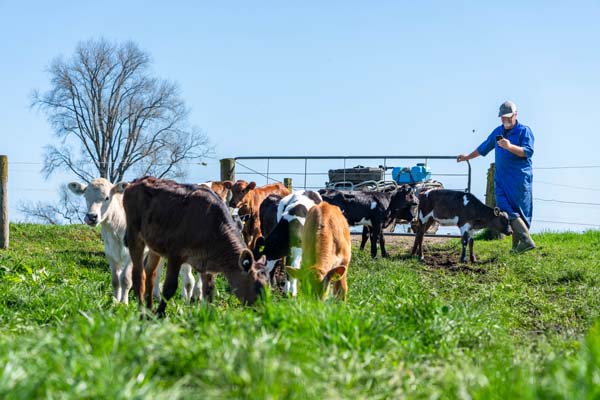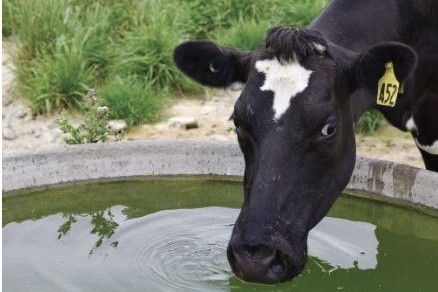Dietary changes, weaning and other stressors on cattle can cause vitamin B1 deficiency, which in turn can cause blindness. Dr Rory Dean describes the signs to watch for and what to do when you see them.
In 1884, Polish scientist Casmir Funk discovered four chemical substances were required in humans’ diets for essential functions. He found these substances seemed to contain an amine chemical group and he termed them “vital amines”, which would eventually be shortened to “vitamins”. One of the original four vitamins he discovered was thiamine, or vitamin B1. All ruminants have an essential requirement for thiamine, which helps support, among other things, a healthy neurological system.
In healthy ruminants fed sufficient roughage, plentiful thiamine is normally produced by thiamine-producing bacteria in the rumen.
Thiamine deficiency in cattle occurs under several circumstances that are not fully understood.
Certainly, when cattle are fed diets containing insufficient roughage, thiamine deficiency is common, and this is often a problem in feedlots around the world. Changes in diet, weaning, physiological stress, and sulphur toxicity following fertiliser application are commonly associated with thiamine deficiency. The current and most likely theory for the progression of vitamin B1/thiamine deficiency in these cases is that the stressor causes a shift in the population of bacteria in the ruminal “soup”. This change in rumen bacteria leads to production of thiaminase, an enzyme that breaks down thiamine.
Vitamin B1 is essential for energy supply to the brain in ruminants. Deficiency causes a type of degeneration in the brain called polioencephalomalacia, which causes a variety of symptoms. Affected animals may appear restless, blind, show seizure activity, or wander aimlessly. Often death ensues within 24 hours.
Case example:
During an August weekend, a contract milker sought veterinary advice for a cow that had appeared to be aggressive and had shown seizure activity the night before. She was promptly treated by the farmer with calcium/magnesium and pain relief, but seemed to not respond to therapy. Owing to damage the animal sustained during seizures and being cast overnight, the decision was made to euthanise her on welfare grounds.
The following week, a first lactation heifer was presented to me as suddenly blind. She gave around 20 litres of milk the night before, and seemed normal. The staff reported her able to keep up with the herd in the morning, but when on her own she would walk into objects. She had reduced milk yield and had poor ruminal fill as if she hadn’t eaten overnight. On examination, I found her to be completely blind and showing evidence of not having eaten overnight. Other than some evidence of head pain, her neurological examination was normal. She was blood sampled and treated with Vitamin B1 (thiamine) and dexamethasone, a potent steroid anti-inflammatory medication. The following day the heifer appeared to be eating well, but was still blind. Subsequently, another first lactation heifer was found to be blind, with her head raised and showing a “high stepping” gait. She had clearly been having seizures, was covered in mud and was easily tackled to the ground in the paddock. She was given the same therapy comprising the vitamin B1 injection and dexamethasone, and the first heifer was re-treated. Blood samples showed changes suggestive of muscle damage, which is caused when blind animals walk into objects, and the absence of lead in the blood helped me rule out lead toxicity as the cause of the blindness.
The heifers were in great condition, and were milking well. They had recently been moved down from the runoff, where kikuyu grass predominated, on to a diet comprising ryegrass, maize silage and distillers dried grains. While this is a great diet for early lactation animals, in this case the dietary change and the physiological stress heifers were under in their first lactation may have contributed to a change in their rumen bacteria population, leading to thiamine deficiency. Most cases of thiamine deficiency are seen in young cattle under one year of age, so this was a challenging, unusual case.
It was decided to orally drench all 200 heifers in the mob with thiamine powder made into a solution, and reduce the amount of starch in the diet. The two heifers that were treated by me were diligently treated with thiamine injections twice to thrice daily by staff, and continued to improve before regaining their sight a week later. After the farm team drenched the heifers and changed the diet, no further cases were seen.
In summary, it is important to involve your veterinarian for advice and diagnosis in managing unusual cases onfarm. Early action, diagnosis and treatment of the mob prevented considerable losses in this case. Treating the individual cows without consideration of the rest of the heifer mob would have led to huge losses had this farmer not acted early and aggressively.
Moreover, the diligent treatment and nursing care is the primary reason behind the positive outcomes in the two heifers that were treated for thiamine deficiency in this case.





